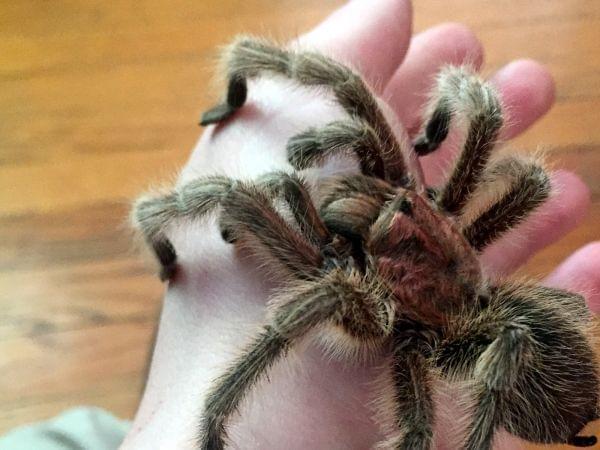Insects and Other Arthropods vs. Humans: Who Should Fear Whom?

The photographer's pet tarantula on his hand. Charles Dean
In anticipation of the 34th Annual Insect Fear Film Festival, which they will host Saturday on the U of I campus, this week's commentary comes from members of the Entomology Graduate Student Association Todd Johnson, and Tanya Josek. While films at the festival show insects and their relatives threatening people, my guests are here to we explore whether they should they fear us.
Rhinoceros beetles are named after their characteristic horns that emerge from the center of their heads. In the movie Caved In, they use this horn to attack the unsuspecting humans that stumbled into their underground dwellings. In reality, this horn is a weapon, but not in the way the movie depicts. Male rhinoceros beetles use their horns to grapple with each other in attempt to court females. The winner of these duels gets to mate, and the loser often has to continue grappling with other males. Winners do not always have the biggest horns, as having a big horn may affect the beetle's ability to crawl through the underground tunnels where they live.
Rhinoceros beetles are also popular pets in certain parts of Asia. They are easy to maintain and require little attention. Because male rhinoceros beetles have a natural tendency to fight with each other, they have also been historically associated with gambling. Spectators bet on the beetle they think will win the wrestling match to gain the right to court a female.
Other arthropods, such as tarantulas, are also kept as pets. These animals often display stunning coloration and are mostly docile. Because of their popularity, the international pet trade has virtually eliminated some species of tarantulas from their native habitats.
The bite of tarantulas is often portrayed as dangerous to humans even though nobody has ever died as the direct result of a tarantula bite. The human bite is another story, as recipes for “fried spider” and “cooked tarantula on a stick” attest. The larval stages of rhinoceros beetles have been touted as protein-rich snacks, potentially serving as viable sources of protein for wide scale distribution. Per serving, some of these insects have more protein than both chicken and beef, and they can easy to cultivate.
Populations of insects and other arthropods also sometimes suffer for the sake of art. Their brilliant colors, captivating patterns, or unique and interesting shapes make them attractive as pieces of jewelry and decoration. For instance, some jewelers collect part of the exoskeleton of beetles and make earrings, necklaces, and other pieces from them. Other artists arrange large numbers of pinned insects into elaborate patterns.
While horror movies may depict arthropods as frightening creatures, it may be more appropriate for them to fear us. Humans catch and contain arthropods, mutate them, wear them as jewelry, and even eat them. One may even come to the conclusion that these animals are realistically less likely to be the monsters, and more often than not, the victims. But, be prepared for the tables to be turned as the arthropods attack in Paul Hertzberg's Insect Fear Films!
Foellinger Auditorium opens to the public at 6pm, where insect-related artwork created by students from local schools, and displays of insects from different parts of the world can be viewed. Visitors can also enjoy face painting and balloon insects, as well as our insect petting zoo. Chair of the Entomology Department, May Berenbaum will give an introduction at 7:00 with the films starting at 7:30. For more information visit the IFFF Facebook page or website.

